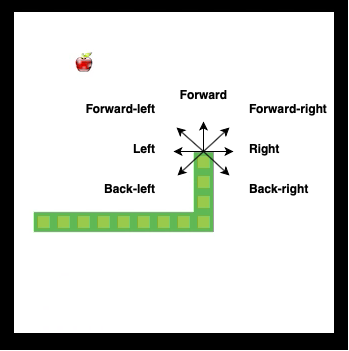The goal of this project was to train an AI bot to play Snake. The bot didn’t get any information about the rules of the game - it had to guess them by itself. All information it got was snake vision and information about reward or penalty. The game and the bot were written in Python.
Check it also on my GitHub repository.
Algorithm
I implemented a Deep Reinforcement Learning algorithm - Deep Q Neural Network.
Input - Snake vision
The neural network input is a 21 element vector. It represents snake vision. There are three types of objects: wall, snake body and fruit. For each object type, the vector contains 7 numbers that represent distances to the nearest object in every direction.
| Object | Object | Object | Object | Object | Object | Object |
|---|---|---|---|---|---|---|
| Back-left | Left | Forward-left | Forward | Forward-right | Right | Back-right |

The distance in the vector is a floating-point number, with a maximum value of 1 and a minimum of 0. It is calculated with the following equation:
1 / distance
The value of 1 means that the object is very near and the value of 0 means it is very far away.
Output
There are 3 outputs from the neural network - possible snake moves. Snake can go either forward, left or right.
Moves limit
I have introduced a limit of moves to prevent the snake from spinning around. After eating fruit the counter of remaining moves is reset. Also, the larger the snake, the more movements it has.
Rewards
- eating a fruit - reward
- game end - penalty
Experience replay
There is a limited replay buffer that stores the information about last moves:
- current state,
- decision,
- reward,
- next state,
- is game ended.
After each game, some random tuples are being taken from this buffer and they are used to train the neural network. It helps to avoid forgetting previous experiences and helps to reduce correlations between experiences (if tuples are being taken from buffer randomly).
Random moves
During training, random decisions are occasionally taken to allow the snake to better explore space in search of the best global solution. This happens according to the algorithm of simulated annealing. In the first games, the probability of choosing a random move is the highest and decreases with each subsequent game.
Results

Conclusions/Notes
- The initial positions of the snake and fruit during training are fixed. Finding fruit faster in the early stages of the game resulted in faster learning due to early recognition of the reward.
- Adding moves left counter and decreasing the value of learning rate in Adam optimizer resulted in less spinning around of snake.
- Adding random moves in early stages resulted in much faster learning and helped to achieve much higher results.
Code
The code is on my GitHub repository.
Requirements
- Python 3
Installation
git clone https://github.com/pawelkami/AI-Snake
cd AI-Snake/
python3 -m venv venv
source venv/bin/activate
pip3 install -r requirements.txt
Launching program
usage: snakeGame.py [-h] [--speed SPEED] [--count COUNT] [--ai] [--train]
optional arguments:
-h, --help show this help message and exit
--speed SPEED Speed of game. 0 is the fastest. Default: 100
--count COUNT Game count to play. Default: 100
--ai AI controlls snake
--train Train AI model
Examples
- Playing the game with your keyboard (keyboard: left and right arrow keys).
python3 snakeGame.py - Training the model (speed should be 0 for the fastest training).
python3 snakeGame.py --ai --train --speed 0 - Running the game with the trained model.
python3 snakeGame.py --ai --speed 0
